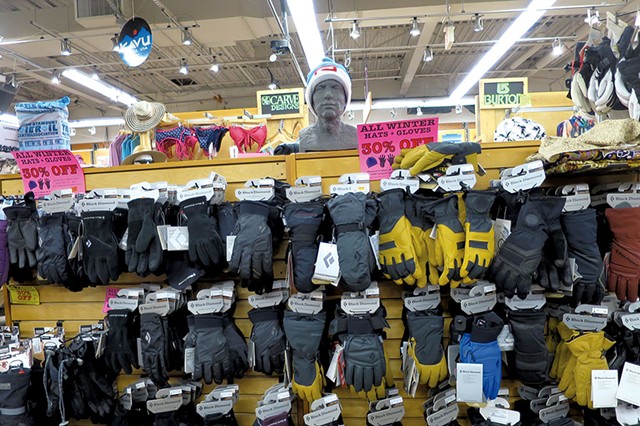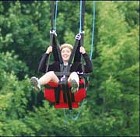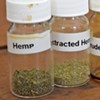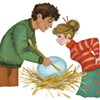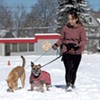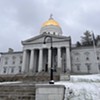Published April 6, 2016 at 10:00 a.m. | Updated April 12, 2016 at 2:21 p.m.
The cross-country skiing was so dismal this winter at Burr Morse's Montpelier farm that he never hit the trails, and paying customers were scarce. "We were open about three weeks, with minimal snow," he said. "The snow went away and never came back."
But when the dismal winter yielded to an early spring, sweet sap gushed from Morse's maple trees at a greater volume than he's seen in three years.
"It's just been great," he said. "The syrup we've made is second to none this year."
Morse's skiing and maple syrup businesses put him in a rare position to see both the bust and the boom of 2015-16's extreme weather.
This was a winter like no other. It stands to be both the warmest and possibly the least snowy on record in Burlington, according to the National Weather Service. Those superlatives made their mark on Vermonters' wallets, in good ways and bad.
Fewer people thought about buying new skis, boards or snowmobiles. Fewer skiers converged on Vermont slopes, meaning less business for gas stations, hotels and restaurants, as well as resorts. Fewer people bought new snow shovels or warm socks.
But if the downsides were really down, the wacky winter had financial upsides, too. Vermonters spent far less heating their homes, having their driveways plowed and replacing their car batteries. The state, and every town and city, saved money as warmer-than-usual temperatures — rather than road salt — melted what little ice there was.
National Weather Service figures for Burlington tell the story: The average mean temperature was 30.1 degrees — eight degrees warmer than normal. December and January's temps averaged nine degrees higher than during the previous year; February's, nearly 19 degrees higher.
Only 30.8 inches of snow had fallen at the Burlington International Airport through last week, compared with an average yearly snowfall of 75.7 inches, said Weather Service meteorologist Peter Banacos. The service counts annual snowfall from July through June. Unless more snow falls this month, 2015-16 will likely make history as the least-snowy year since the Weather Service began keeping records in 1883, Banacos said. The previous low was 31.8 inches, in 1912-13, he said.
The effect of those numbers was obvious to Mike Donohue every time he looked out his back door in Richmond. He saw so little snow that he never strapped on skis for his usual backwoods run.
His customers at Outdoor Gear Exchange in Burlington, which he co-owns, were in no mood to buy equipment. "Snowshoes sales were really flat," he said. "Gloves and hats, some months they were down 40 percent."
Online sales to customers around the country helped soften the blow to OGE, Donohue said. The store also bought discounted leftover gear from manufacturers to sell next year, he said, in hopes that winter rebounds.
Frances Anderson, owner of Stone Hearth Inn & Tavern in Chester, advertises her inn as sled-in, sled-out for snowmobilers, because the Vermont Association of Snow Travelers trail runs right by the back door. This year, she said, "There were none."
"We had reservations, and they were canceled. People who have sleds and normally ride here didn't," Anderson said.
Some visitors enjoyed the man-made snow for downhill skiing at nearby Okemo, Bromley and Stratton, but there were no cross-country skiers. Business was down, particularly weekdays, at Anderson's restaurant, too, she said. Accordingly, employees worked fewer hours.
So did Mike Mutty. The Winooski man runs a small business plowing driveways and parking lots for homeowners and businesses. Mutty didn't make his first run of the winter until December 30, he said. Normally by then, he'd have gone out four or five times. That pace never picked up.
"I maybe plowed, like, a 10th of what I did last year," Mutty said.
The key to surviving such ups and downs is diversifying. Mutty also operates an auto-detailing business, does summer lawn maintenance and just took a security job. "I don't solely rely on plowing as income," he said.
Hart & Mead owner Doug Mead runs a home-heating-oil delivery service, an auto-repair shop, an auto-parts store and a car wash in Hinesburg. His heating-oil customers didn't need nearly as much fuel as usual, so he kept his employees busy doing maintenance work instead. Looking over the records of one customer, Mead said, the household used just 692 gallons of fuel oil this winter, compared to 870 gallons the previous year.
Mead's auto-repair customers tended to save money, too. The warm winter was easy on batteries, starters and alternators, he said.
The state and municipalities saved on clearing roads. The City of Burlington spent $387,772 less this winter than last on plowing, equipment maintenance and salt, said Bob Rusten, the city's chief administrative officer.
The state Agency of Transportation spent $4 million less on employee overtime and salt, according to agency Secretary Chris Cole. Through March 28, he said, the state had used 61,614 tons of road salt, compared to 122,430 the previous year.
State highway workers were called out for far fewer all-night snowplowing feats. They put in just 28,254 collective hours of overtime, compared to 49,872 the previous year. Total winter maintenance spending was down by about a third: $19.1 million this year, compared to $28.8 million last year.
But as winter gave, it also took from state coffers. Gas-tax revenues that fuel the state transportation funds were down $2.3 million, Cole said, speculating that fewer tourists meant less gas purchased.
Other state revenues saw some impact from a weak winter tourism season, but Administration Secretary Justin Johnson noted they are not as far off target as one might expect. The sales tax, which is charged on items such as skis, lift tickets and snowblowers, was 1.73 percent less than expected for the fiscal year through February. The rooms-and-meals tax, charged at hotels and restaurants, was only 0.01 percent below expectations. March revenue figures are due out this week.
Rep. Adam Greshin (I-Warren) watches tax revenues closely as a member of the House ways and means committee. He's also a co-owner of Sugarbush Resort.
Skier days, a measure that counts the number of days skiers visit the slopes, were down about 25 percent this winter, Greshin said.
Like other ski areas, Sugarbush made more snow than usual, and far later into the season. Typically, Vermont ski areas end snowmaking in mid-February because they have a deep enough base, but that base never materialized this year.
Greshin said skiers who had long-planned vacations tended to come, as holiday bookings remained strong. But off-holiday, spur-of-the-moment trips were down.
Cole, the transportation secretary, was among those skiers who stayed away. "I've skied four days so far this year," he said last week. Typically, he said, he makes 15 to 20 trips to Sugarbush and Mad River Glen in a season.
That lull in business hit Sugarbush's workforce "slightly," Greshin said, translating to fewer hours for some employees, such as ski lift operators and hotel workers.
Most ski areas are positioned to handle the occasional bad winter, Greshin said. "You can't get into this business without anticipating — indeed, even expecting — a bad winter or two," he said. "Like a good chipmunk, you sock away your nuts."
But this season was unique in his 15 years at Sugarbush, he conceded. "We've never had as bad a winter."
The original print version of this article was headlined "Winter Winners and Losers"
More By This Author
About the Artist

Matthew Thorsen
Bio:
Matthew Thorsen was a photographer for Seven Days 1995-2018. Read all about his life and work here.
Matthew Thorsen was a photographer for Seven Days 1995-2018. Read all about his life and work here.
Speaking of...
-

Totality Towns: What to Do and See in the Path of the Eclipse
Apr 2, 2024 -

Montpelier: What to See, Do and Eat During the Eclipse
Feb 10, 2024 -

Burlington: What to See, Do and Eat During the Eclipse
Jan 25, 2024 -

Slow Holiday Season Leads to Layoffs at Outdoor Gear Exchange
Jan 10, 2024 -

Winter Wanderland: Taking a Winter Walk Doesn't Have to Be a Chore
Nov 14, 2023 - More »
Comments
Showing 1-1 of 1
Comments are closed.
From 2014-2020, Seven Days allowed readers to comment on all stories posted on our website. While we've appreciated the suggestions and insights, right now Seven Days is prioritizing our core mission — producing high-quality, responsible local journalism — over moderating online debates between readers.
To criticize, correct or praise our reporting, please send us a letter to the editor or send us a tip. We’ll check it out and report the results.
Online comments may return when we have better tech tools for managing them. Thanks for reading.



































